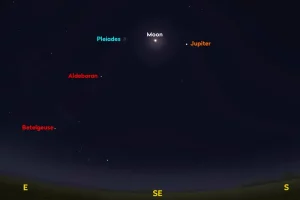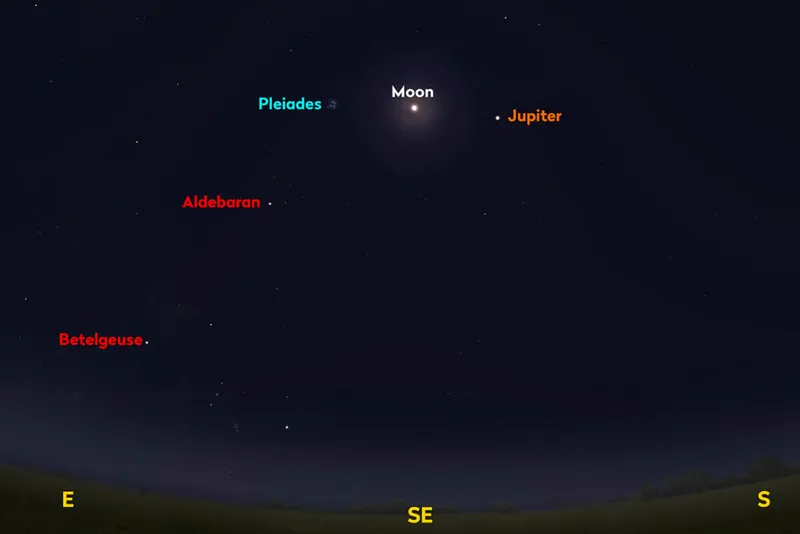As we turn our gaze towards the celestial heavens this month, there’s a prominent celestial body that’s set to dominate the evening sky. Jupiter, the largest planet in our solar system, is approaching opposition – the point at which it’s closest to Earth for the year. This astronomical event promises to be a visual treat for stargazers, as Jupiter rises in the eastern sky with the onset of darkness and continues to shine brightly throughout the night as it gracefully traverses the celestial expanse.
Jupiter’s Yearly Journey Through the Zodiac
Jupiter’s celestial journey is a fascinating one. It takes this gas giant approximately 12 years to complete a full orbit around the Sun, which means it spends a year in each of the 12 constellations of the zodiac. In the current year, Jupiter finds itself within the boundaries of Aries, the Ram constellation, not too far from the familiar Pleiades star cluster.

Perihelic Opposition: A Special Astronomical Occurrence
However, not all oppositions of Jupiter are created equal. Jupiter, like Earth, follows an elliptical orbit around the Sun, which means there are times when it comes closer to the Sun (and consequently, Earth) and other times when it moves farther away. This year, Jupiter is in a special position. It’s experiencing a perihelic opposition, which occurs when Jupiter is closest to the Sun. This celestial alignment brings Earth and Jupiter in exceptionally close proximity.
On November 2, 2023, Jupiter reached opposition, and it was a mere 370 million miles away from Earth. This makes Jupiter appear as large and bright as it can get from our vantage point. Such a remarkable event won’t happen again until 2034, so it’s a rare opportunity to witness the giant planet at its best.
Exploring Jupiter’s Intriguing Features
Observing Jupiter through a backyard telescope is a delightful experience. The planet exhibits prominent dark cloud stripes and features the iconic Great Red Spot, a massive storm system. Additionally, there are four planet-sized moons that change their positions around Jupiter each night.
Back in 1610, the renowned Italian astronomer Galileo Galilei discovered these four moons using a humble 1-inch telescope. They were subsequently named Io, Europa, Ganymede, and Callisto. Regardless of the telescope you possess, you can observe these moons as they orbit the colossal planet. This year’s perihelic opposition provides the perfect occasion to embark on this celestial journey and explore the ever-changing dance of Jupiter’s moons.
Taurid Meteor Showers: A Celestial Bonus
While you revel in the brilliance of Jupiter, keep an eye on the night sky for an additional celestial spectacle. It’s time for the annual Taurid meteor showers to reach their peak of activity.
The Taurid meteor showers derive their name from the constellation of Taurus, the Bull, as they appear to radiate from this stellar region. These meteor showers are linked to a comet named Encke (pronounced “inky”) – a celestial traveler first tracked by astronomer Johann Franz Encke in 1819. Interestingly, Comet 2P/Encke, as it is formally known, is believed to be a fragment of a much larger body that disintegrated into pieces thousands of years ago.
Comet 2P/Encke follows an orbit that comes remarkably close to Earth’s path in early November, and as a result, fragments of this comet’s debris rain down into Earth’s atmosphere. These fragments travel at an astounding speed of about 17 miles per second. As they plunge through our protective atmosphere, they ignite and create a mesmerizing display of meteors, often referred to as “shooting stars.”
It is worth noting that Comet Encke’s debris stream encountered Jupiter in the distant past, resulting in its division into two parallel branches – the South Taurids and the North Taurids. The South Taurid meteor shower peaks on November 5, while the North Taurid meteors reach their zenith on November 12. These meteor showers are active from September 25 to November 25, offering a window of celestial wonder.
While the Taurid meteor showers may not be the most prolific in terms of meteor numbers, they compensate with their luminous and captivating fireballs. Stargazers can anticipate witnessing a handful of Taurid meteors every hour. What sets these meteors apart is their size, brightness, and relatively slower speed. These meteors often appear as brilliant, slow-moving streaks in the night sky, making them a favorite for many observers.
So, as you look up at the night sky in the coming weeks, remember to greet Jupiter in all its glory and keep an eye out for the mesmerizing Taurid meteor showers, a celestial bonus that adds a touch of magic to our evenings.









